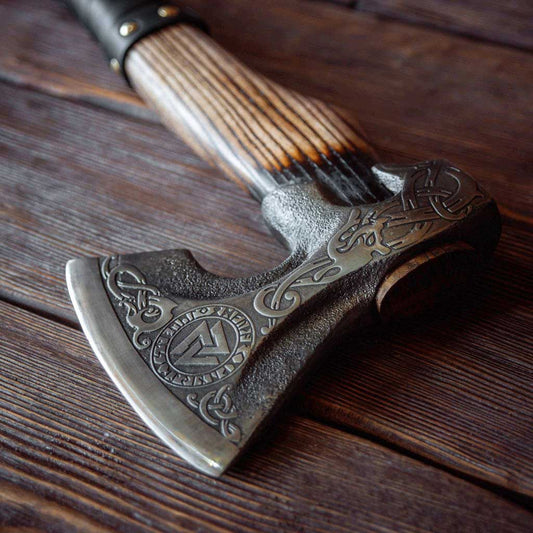Viking Battle Ax


Viking Battle Ax
Regular price
$262.00 USD
Sale price
$262.00 USD
Regular price
$292.00 USD
Scandinavian Viking Ax


Scandinavian Viking Ax
Regular price
$581.00 USD
Sale price
$581.00 USD
Regular price
$581.00 USD
Viking Ax Helm of Dread


Viking Ax Helm of Dread
Regular price
$365.00 USD
Sale price
$365.00 USD
Regular price
$365.00 USD
Dark Valknut Viking Ax


Dark Valknut Viking Ax
Regular price
$365.00 USD
Sale price
$365.00 USD
Regular price
$365.00 USD
Yggdrasil's Viking Ax


Yggdrasil's Viking Ax
Regular price
$292.00 USD
Sale price
$292.00 USD
Regular price
$292.00 USD
Barbarian's Viking Ax


Barbarian's Viking Ax
Regular price
$566.00 USD
Sale price
$566.00 USD
Regular price
$566.00 USD
Oseberg Viking Ax


Oseberg Viking Ax
Regular price
$292.00 USD
Sale price
$292.00 USD
Regular price
$292.00 USD
Borre Style Viking Ax


Borre Style Viking Ax
Regular price
$322.00 USD
Sale price
$322.00 USD
Regular price
$322.00 USD
Viking Ax Prow of Drakkar


Viking Ax Prow of Drakkar
Regular price
$277.00 USD
Sale price
$277.00 USD
Regular price
$277.00 USD
Norse Trinity Viking Ax


Norse Trinity Viking Ax
Regular price
$365.00 USD
Sale price
$365.00 USD
Regular price
$365.00 USD
Black Steel Viking Ax


Black Steel Viking Ax
Regular price
$581.00 USD
Sale price
$581.00 USD
Regular price
$581.00 USD
Medieval Viking Ax


Medieval Viking Ax
Regular price
$655.00 USD
Sale price
$655.00 USD
Regular price
$655.00 USD
Fenrir's Sharp Viking Ax


Fenrir's Sharp Viking Ax
Regular price
$360.00 USD
Sale price
$360.00 USD
Regular price
$392.00 USD
Asgeir Viking Ax


Asgeir Viking Ax
Regular price
$336.00 USD
Sale price
$336.00 USD
Regular price
$336.00 USD
Bear Paw Viking Ax


Bear Paw Viking Ax
Regular price
$365.00 USD
Sale price
$365.00 USD
Regular price
$365.00 USD
Ulfr Viking Ax


Ulfr Viking Ax
Regular price
$408.00 USD
Sale price
$408.00 USD
Regular price
$408.00 USD
Ax Viking Gotland


Ax Viking Gotland
Regular price
$1,045.00 USD
Sale price
$1,045.00 USD
Regular price
$1,045.00 USD
Perun's Viking Ax


Perun's Viking Ax
Regular price
$581.00 USD
Sale price
$581.00 USD
Regular price
$581.00 USD
Valhalla Viking Ax


Valhalla Viking Ax
Regular price
$437.00 USD
Sale price
$437.00 USD
Regular price
$437.00 USD
Runic Viking Ax


Runic Viking Ax
Regular price
$510.00 USD
Sale price
$510.00 USD
Regular price
$510.00 USD

























